A Prediction Method for Hydrocarbon Distribution Associated with Fault-Shale Caprock Configuration Leakages
Abstract
:1. Introduction
2. Mechanism and Distribution of Fault-Shale Caprock Configuration Leakages
3. Prediction Methods for Hydrocarbon Distribution Associated with Fault-Shale Caprock Configuration Leakages
4. Application Example
5. Discussion
6. Conclusions
- (1)
- The hydrocarbon distribution associated with fault-shale caprock configuration leakages is jointly determined by hydrocarbon accumulation at deep basin, fault-shale caprock configuration leakages, and predominant pathways in fault systems. The more developed they are, the more favorable it is for the lower oil and gas to accumulate and form reservoirs in the shallow layer. On the contrary, it is not conducive to oil and gas accumulation.
- (2)
- A determination method for oil and gas distribution at shallow basin is established through superposing oil and gas accumulation at deep basin, fault-shale caprock configuration leakages, and conducting faults. It is demonstrated by predicting hydrocarbon distribution at the Ed-3 Member in the south of the northern Dagang area.
- (3)
- Predicted oil and gas distribution at the Ed-3 Member in the south of the northern Dagang area are mainly occurred in the middle of the north and in the middle of the south edge. This matches well with discovered oil and gas in this area.
- (4)
- This method is valid to predict oil and gas accumulating at shallow reservoirs of “lower generation, upper accumulation” associated with fault-shale caprock configuration leakages in petroliferous basins.
Funding
Institutional Review Board Statement
Informed Consent Statement
Data Availability Statement
Acknowledgments
Conflicts of Interest
References
- Liu, Z.; Lü, Y.F.; Sun, Y.H. Characteristics and significance of syngenetic fault segmentation in hydrocarbon accumulation, an example of Yuanyanggou fault in western sag, Liaohe depression. J. China Univ. Min. Technol. 2012, 41, 793–799. [Google Scholar]
- Lv, Y.; Wan, J.; Sha, Z.; Fu, X.; Fu, G. Evaluation method and application of sealing ability of shale caprock damaged by fault. Geosciences 2008, 43, 162–174. [Google Scholar]
- Wang, H.; Wang, F.; Wu, T.; Fu, X.F.; Meng, L.D.; Feng, Y.G.; Liu, S.F. Trends and application of fault vertically segmented growth in the hydrocarbon exploration and production. Prog. Geophys. 2019, 34, 2336–2345. [Google Scholar]
- Fu, X.; Sun, B.; Wang, H.; Meng, L.D. Fault segmentation growth quantitative characterization and its application on sag hydrocarbon accumulation research. J. China Univ. Min. Technol. 2015, 44, 271–281. [Google Scholar]
- Hu, C.; Fu, G.; Zhan, M. Hydrocarbon Upward Uigration Condition in Different Directions and Prediction Method of Distribution Area. Geol. Rev. 2018, 64, 227–236. [Google Scholar]
- Shi, J.; Li, L.; Fu, G. Quantitave Evaluation Method and Application of Vertical Sealing Property of Faults in shale caprock. J. Jilin Univ. 2012, 42, 162–170. [Google Scholar]
- Liu, B.; He, S.; Meng, L.; Fu, X.; Gong, L.; Wang, H. Sealing mechanisms in volcanic faulted reservoirs in Xujiaweizi extension, northern Songliao Basin, northeastern China. AAPG Bull. 2021, 105, 1721–1743. [Google Scholar] [CrossRef]
- Liu, B.; Liu, K.; Abarghani, A.; Khatibi, S.; Kong, L.; Rafieepour, S.; Li, X.; Ostadhassan, M. 1D mechanical earth modeling in the Permian Lucaogou Shale of the Santanghu Basin, Northwest China, from a complete set of laboratory data. Interpretation 2021, 9, T357–T372. [Google Scholar] [CrossRef]
- Schmatz, J.; Vrolijk, P.J.; Urai, J.L. Clay smear in normal fault zones—The effect of multilayers and clay cementation in water-saturated model experiments. J. Struct. Geol. 2010, 32, 1834–1849. [Google Scholar] [CrossRef]
- Fu, G.; Hu, X. Method and application of judging fault vertical sealing property by using argillaceous content of fault rock. Acta Geosci. Environ. 2016, 38, 660–667. [Google Scholar]
- Zhan, M.; Fu, G. Effective sealed part prediction in the fault-shale caprock configuration on seismic data. Oil Geophys. Prospect. 2018, 53, 842–848. [Google Scholar]
- Fu, G.; Yang, J. Sealing of matching between fault and shale caprock to oil gas migration along faults: An example from middle and shallow strata in Nanpu Depression. Earth Sci. 2013, 38, 783–791. [Google Scholar]
- Mu, D.; Fu, G.; Chen, X. Oil and gas leakage positions of fault cap rock configuration and its control on hydrocarbon accumulation of Ng3 in Nanpu 1 structure area. J. Jilin Univ. 2018, 48, 1008–1017. [Google Scholar]
- Lv, Y.; Wang, W.; Hu, X.; Guang, F.; Chao, W.; Jiang, W. Quantitative evaluation method of fault lateral sealing. Pet. Explor. Dev. 2016, 43, 310–316. [Google Scholar]
- Yuan, H.; Cao, W.; Yu, Y.; Zhang, Y. Determination method and application of leakage period for oil and gas of fault-shale caprock configuration. Geol. Rev. 2021, 67, 420–428. [Google Scholar]
- Fu, G.; Dong, J.; Peng, W. Determination method and application for the conversion period of fault-shale caprock configuration leakage and sealing. Acta Sedimentol. Sin. 2020, 38, 868–875. [Google Scholar]
- Fu, G.; Liang, M.; Zou, Q.; Mu, D.; Li, Q. Research method and its application to effectiveness of time matching of source-fault-shale caprock. J. China Univ. Pet. 2020, 44, 25–33. [Google Scholar]
- Wang, X.; Liu, Y.; Hou, J.; Li, S.; Kang, Q.; Sun, S.; Ji, L.; Sun, J.; Ma, R. The relationship between synsedimentary fault activity and reservoir quality—A case study of the Ek1 formation in the Wang Guantun area, China. Interpretation 2020, 8, sm15–sm24. [Google Scholar] [CrossRef]
- Wang, X.; Zhou, X.; Li, S.; Zhang, N.; Ji, L.; Lu, H. Mechanism Study of Hydrocarbon Differential Distribution Controlled by the Activity of Growing Faults in Faulted Basins: Case Study of Paleogene in the Wang Guantun Area, Bohai Bay Basin, China. Lithosphere 2022, 2021, 7115985. [Google Scholar] [CrossRef]
- Fan, B.; Dong, Y.; Pang, X. Establishment of effective source rock and hydrocarbon expulsion quantity: Taking Nanpu Sag for example. J. Cent. South Univ. 2012, 43, 229–237. [Google Scholar]
- Fu, G.; Zhan, M. Conversion condition analysis for vertical migration along faults and lateral migration along sand bodies of oil and gas: Taking the local structure of Bohai Bay basin as an example. J. China Univ. Min. Technol. 2017, 46, 336–344. [Google Scholar]
- Zhou, X.; Niu, C.; Teng, C. The relationship between fault activity and hydrocarbon accumulation during the neotectonic movement in the Bozhong area. Oil Gas Geol. 2009, 30, 469–475. [Google Scholar]
- Tong, Y.; Song, L.; Zeng, S.; Cheng, T.; Wei, Y. A new method of recovering stratum denuded thickness by using vitrinite reflectivity. J. Palaeogeogr. 2005, 7, 417–424. [Google Scholar]
- Fu, G.; Wang, H.; Hu, X. Prediction method and application of shale caprock faulted-contact thickness lower limit for hydrocarbon sealing in fault zone. J. China Univ. Pet. 2015, 39, 30–37. [Google Scholar]
- Fu, G.; Wang, H. Determination method and its application of favorable positions for hydrocarbon transport in oil-source fault during different periods. Acta Pet. Sin. 2018, 39, 180–188. [Google Scholar]
- Jiang, Y.; Su, S.; Liu, H.; Wang, Y.; Cui, X. Differential hydrocarbon enrichment of the Paleogene and its main controlling factors in the Bohai Bay Basin. Oil Gas Geol. 2020, 41, 248–257. [Google Scholar]
- Allan, U.S. Model for hydrocarbon migration and entrapment within faulted structures. Am. Assoc. Pet. Geol. Bull. 1989, 73, 803–811. [Google Scholar]
- Aydin, A. Fractures, faults, and hydrocarbon entrapment migration and low. Mar. Pet. Geol. 2000, 17, 797–814. [Google Scholar] [CrossRef]
- Brandes, C.; Tanner, D. Fault mechanics and earthquakes. In Understanding Faults: Detecting, Dating, and Modeling; Tanner, D., Brandes, C., Eds.; Elsevier: Amsterdam, The Netherlands, 2020; pp. 11–80. [Google Scholar]
- Fisher, Q.J.; Harris, S.D.; McAllister, E.; Knipe, R.J.; Bolton, A.J. Hydrocarbon flow across faults by capillary leakage revisited. Mar. Pet. Geol. 2001, 19, 251–257. [Google Scholar] [CrossRef]
- Manzocchi, T.; Childs, C.; Walsh, J.J. Faults and fault properties in hydrocarbon flow models. Geofluids 2010, 10, 94–113. [Google Scholar]
- Moretti, I. The role of faults in hydrocarbon migration. Pet. Geosci. 1988, 4, 81–94. [Google Scholar] [CrossRef]
- Schultz, R. Introduction to Geologic Structural Discontinuities. In Geologic Fracture Mechanics; Schultz, R., Ed.; Cambridge University Press: Cambridge, UK, 2019; pp. 1–26. [Google Scholar]
- Deng, Y. Practical effrct of the “transfer station” model for oil-gas migration in rift basin: A case study on the Tertiary in the Bohai oil province. Acta Pet. Sin. 2012, 33, 18–24. [Google Scholar]
- Zhang, Z.; Zeng, Y.; Zhang, X.; Yuan, D.; Xu, X. The Geochemistry Characteristics and Accumulation-History of Crude Oil in the Bonan Sub-Sag of the Zhanhua Sag, the Bohaiwan Basin. Pet. Geol. Exp. 2006, 28, 54–58. [Google Scholar]
- Xue, Y.; Deng, Y.; Yu, H. Progress and New Knowledge of Exploration for Oil and Gas in Bohai Sea Area in Recent Yaers. China Pet. Explor. 2008, 13, 1–7. [Google Scholar]
- Liu, P.; Jiang, Y.; Liu, H. The relationship between fault-activity and hydrocarbon accumulation of Neogene in Zhanhua Deoression, Bohai Bay. Nat. Gas Geosci. 2013, 24, 541–547. [Google Scholar]
- Jiang, G.; Fu, G.; Sun, T. Seismic data is used to determine the transportation oil-gas ability of oil source faults and the difference of oil-gas accumulation. Prog. Geophys. 2017, 32, 160–166. (In Chinese) [Google Scholar]
- Aydin, A.; Johnson, A.M. Analysis of faulting in porous sandstones. J. Struct. Geol. 1983, 5, 19–31. [Google Scholar] [CrossRef]
- Bruhn, R.L.; Parry, W.T.; Yonkee, W.A.; Thompson, T. Fracturing and hydrothermal alteration in normal fault zones. Pure Appl. Geophys. 1994, 142, 609–644. [Google Scholar] [CrossRef]
- Caine, J.S.; Evans, J.P.; Forster, C.B. Fault zone architecture and permeability structure. Geology 1996, 24, 1025–1028. [Google Scholar] [CrossRef]
- Evans, J.P.; Forster, C.B.; Goddard, J.V. Permeability of fault-related rocks, and implications for hydraulic structure of fault zones. J. Struct. Geol. 1997, 19, 1393–1404. [Google Scholar] [CrossRef]
- Childs, C.; Walsh, J.J.; Watterson, J. Complexity in fault zone structure and implications for fault seal prediction. Nor. Pet. Soc. Spec. Publ. 1997, 7, 61–72. [Google Scholar]

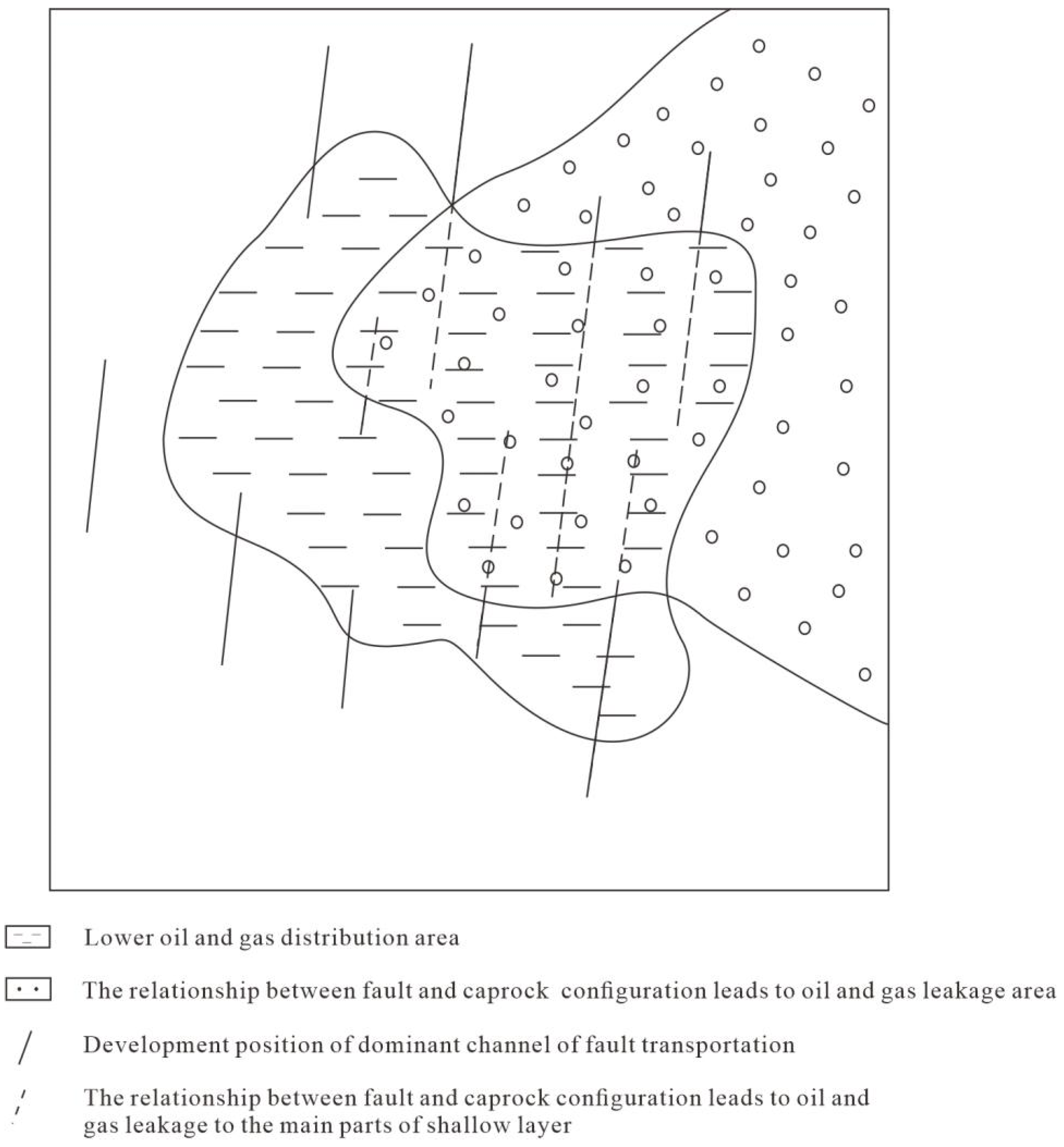
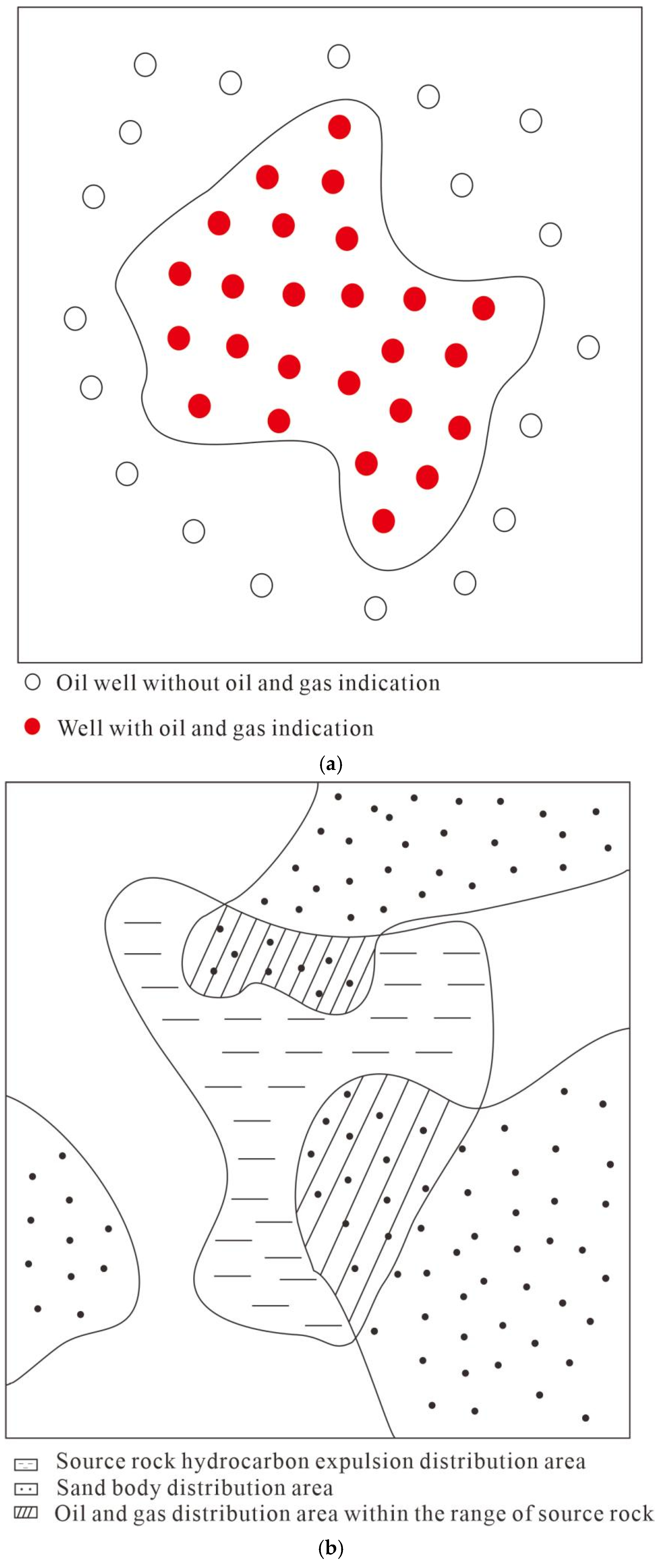
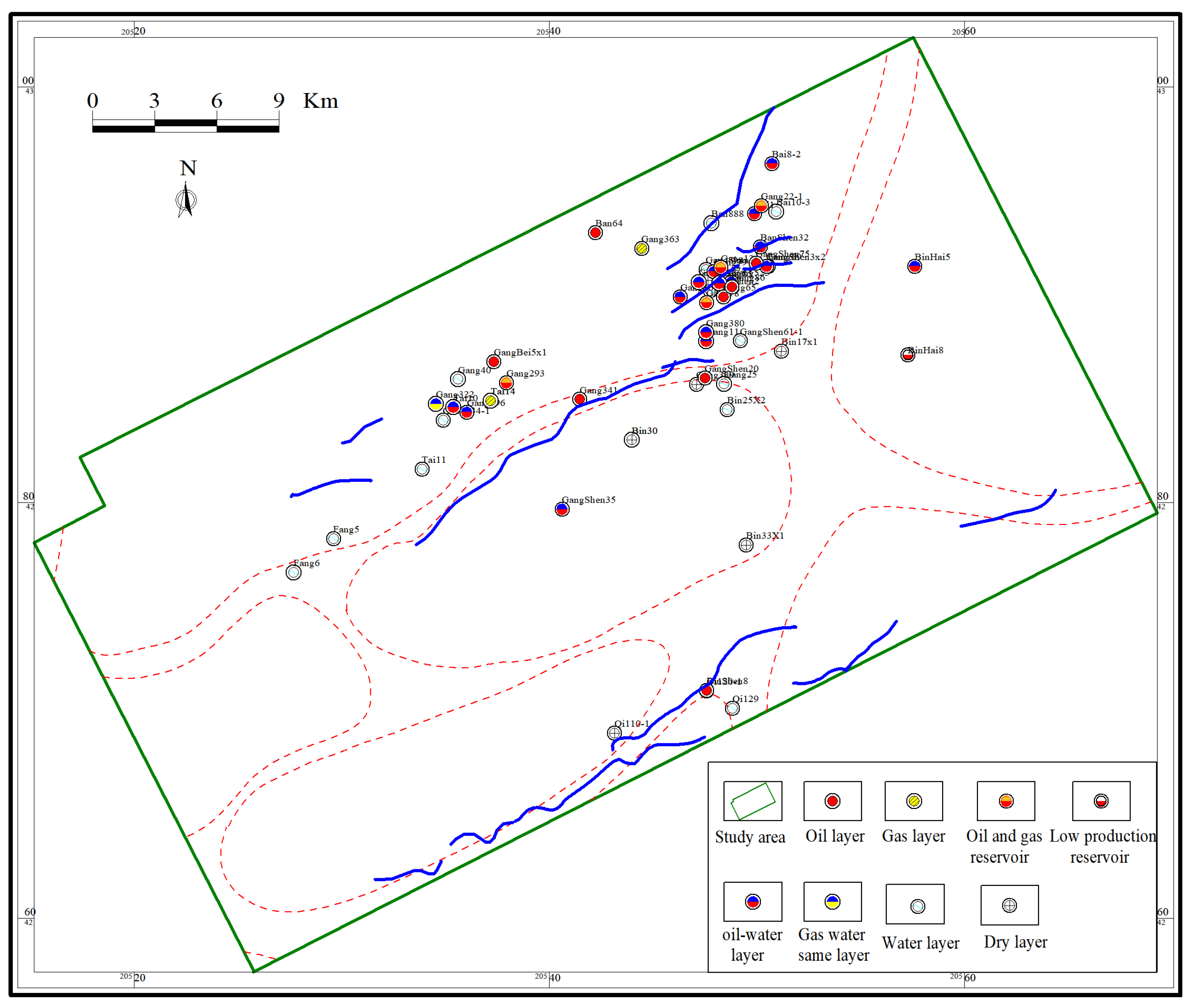

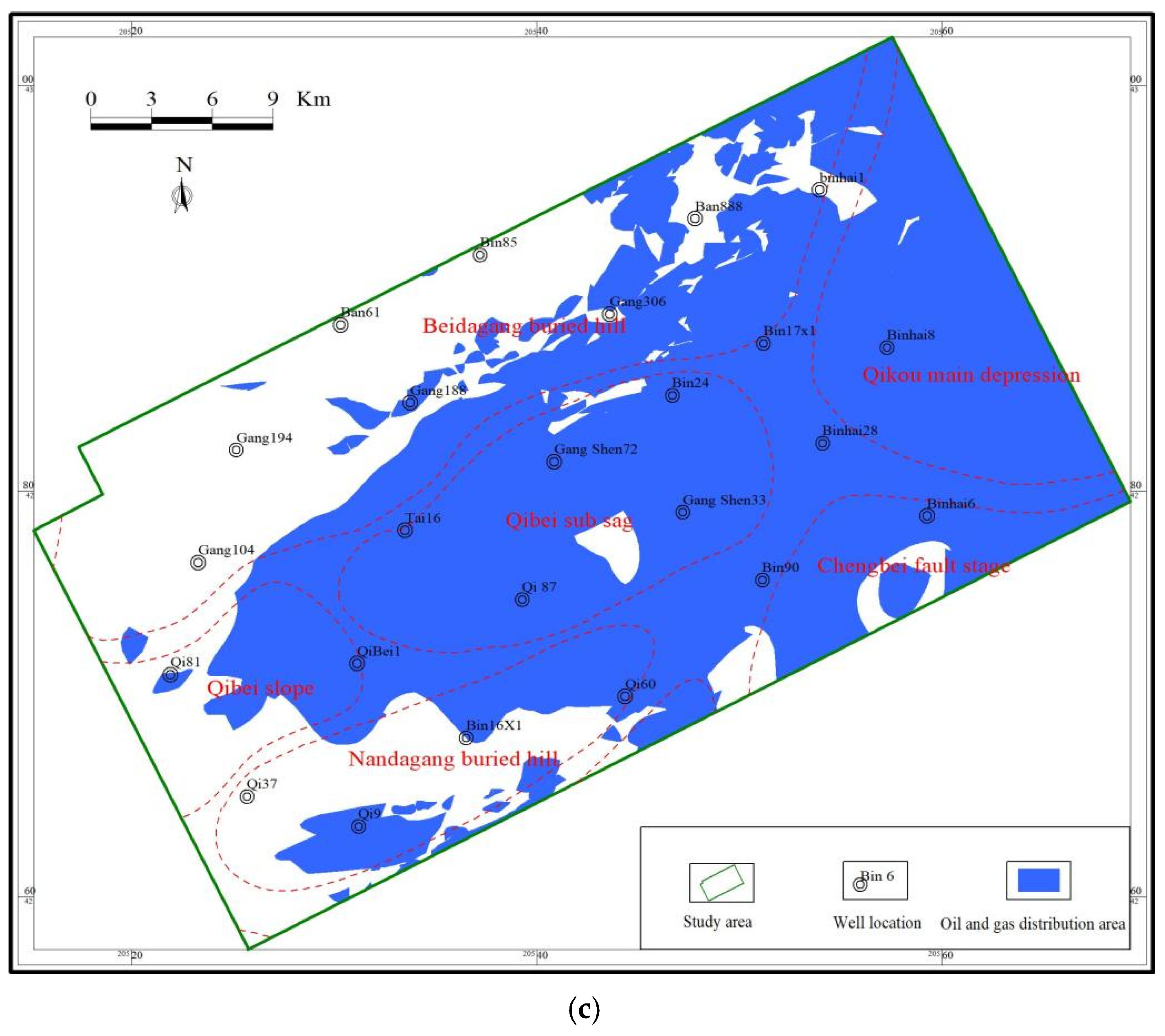
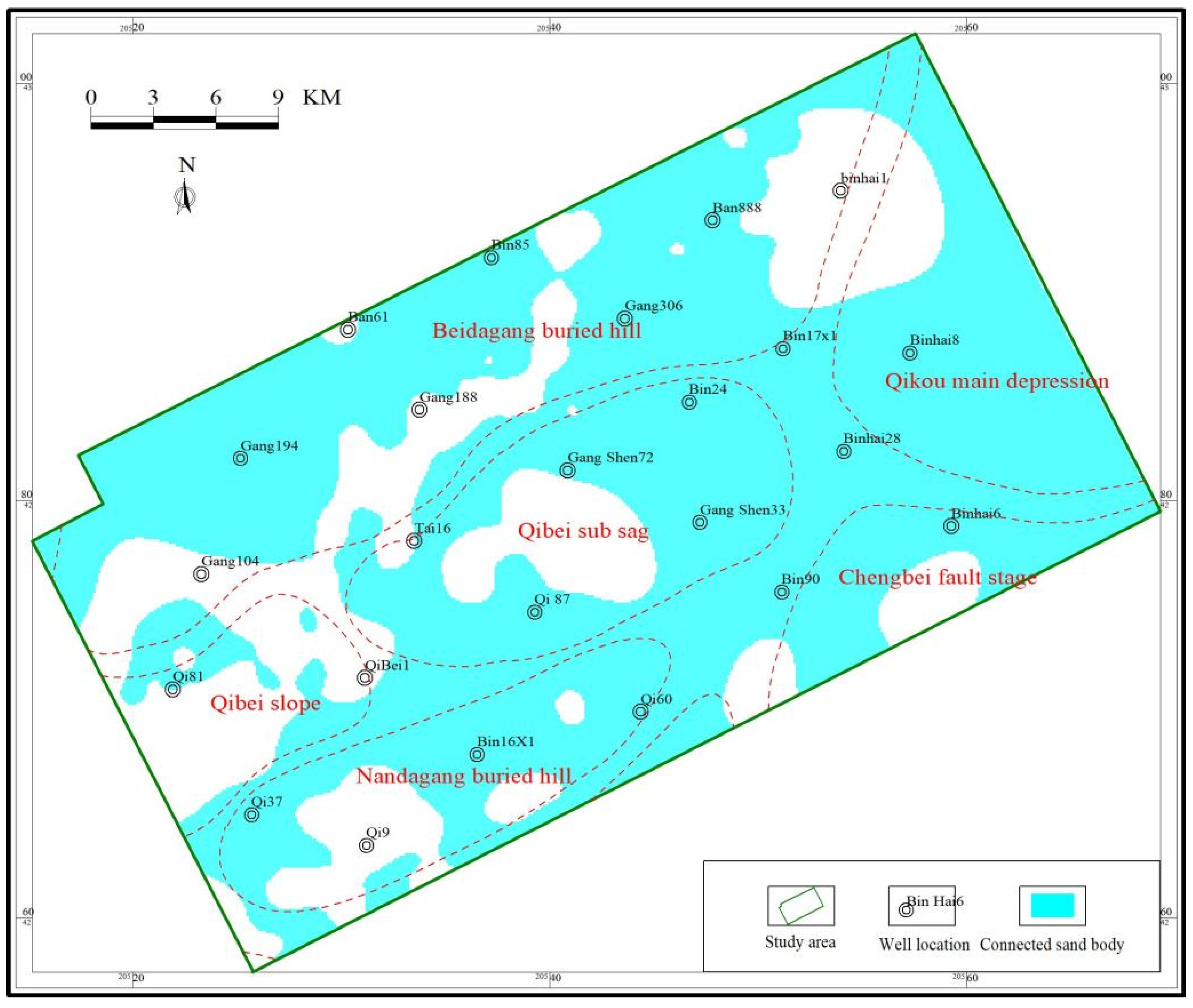
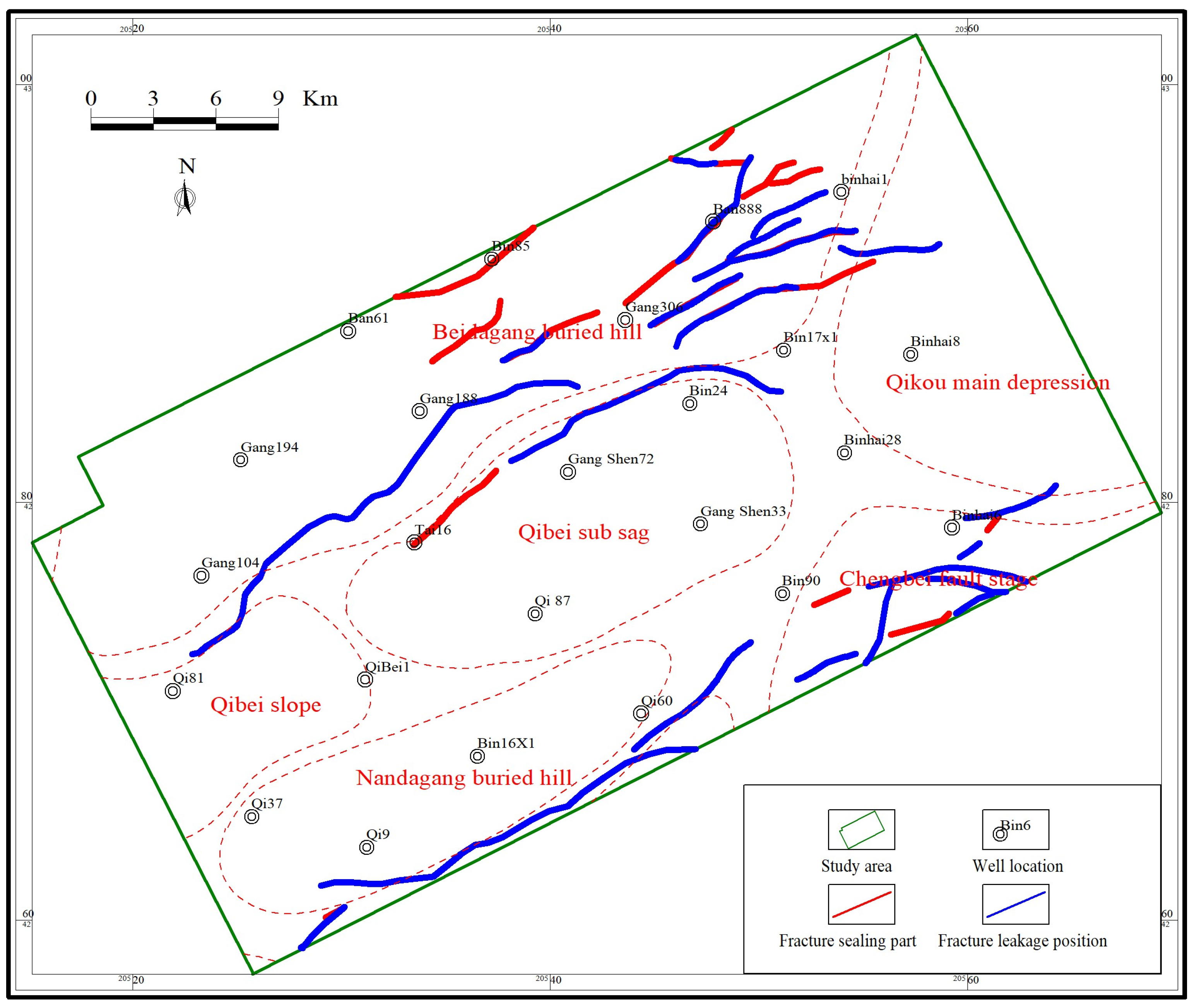

Publisher’s Note: MDPI stays neutral with regard to jurisdictional claims in published maps and institutional affiliations. |
© 2022 by the author. Licensee MDPI, Basel, Switzerland. This article is an open access article distributed under the terms and conditions of the Creative Commons Attribution (CC BY) license (https://creativecommons.org/licenses/by/4.0/).
Share and Cite
Zhang, B. A Prediction Method for Hydrocarbon Distribution Associated with Fault-Shale Caprock Configuration Leakages. Energies 2022, 15, 2867. https://doi.org/10.3390/en15082867
Zhang B. A Prediction Method for Hydrocarbon Distribution Associated with Fault-Shale Caprock Configuration Leakages. Energies. 2022; 15(8):2867. https://doi.org/10.3390/en15082867
Chicago/Turabian StyleZhang, Bowei. 2022. "A Prediction Method for Hydrocarbon Distribution Associated with Fault-Shale Caprock Configuration Leakages" Energies 15, no. 8: 2867. https://doi.org/10.3390/en15082867
APA StyleZhang, B. (2022). A Prediction Method for Hydrocarbon Distribution Associated with Fault-Shale Caprock Configuration Leakages. Energies, 15(8), 2867. https://doi.org/10.3390/en15082867




